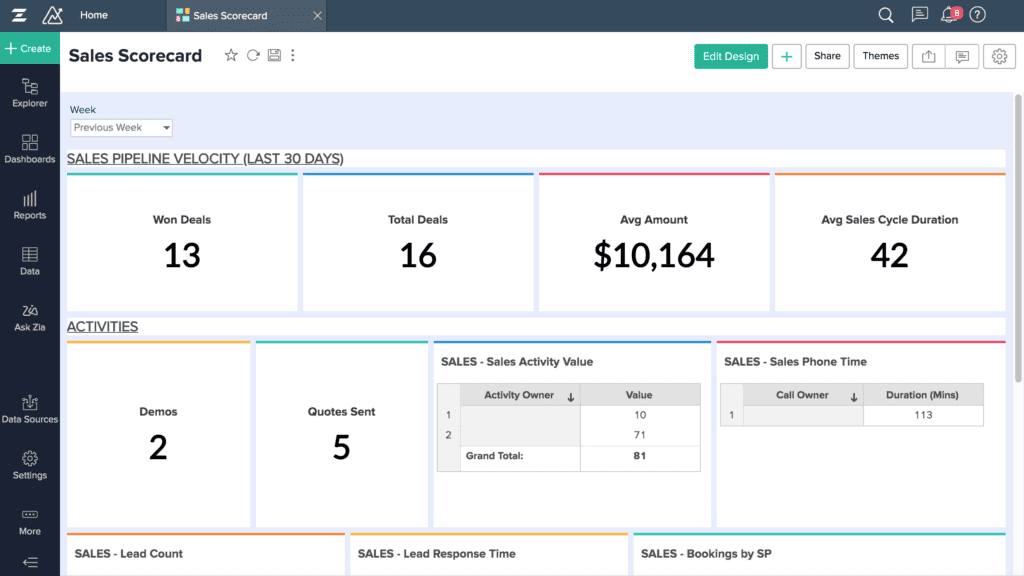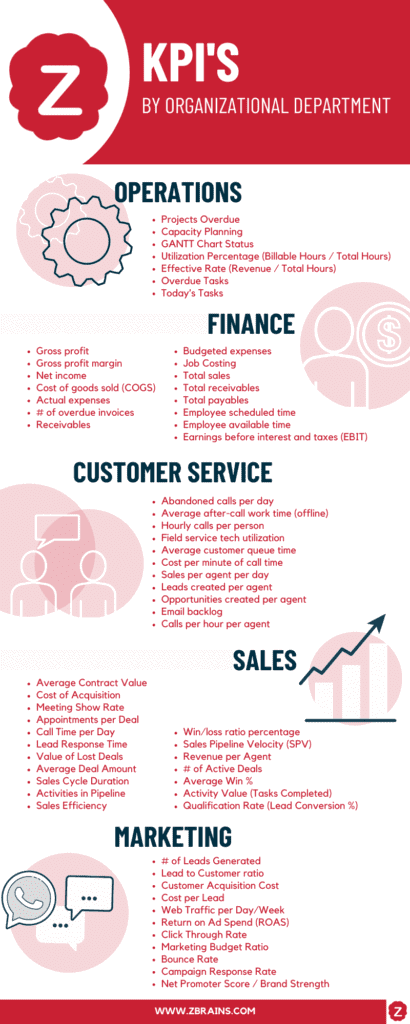Knowing the data you’re already collecting and defining your business goals is the first step in developing a KPI strategy for your organization. (Finding the data that’s missing is where ZBrains can help.) However, today we’re going to share the types of KPI’s you should consider when creating a KPI strategy for your organization. Finally, make sure not to miss the end of the article. We share an infographic of KPI’s you could consider for each department or area of business.
A majority of today’s businesses use multiple systems to capture data about their customers, leads or website visitors, financials, projects, and more.
Many of these companies aren’t fully utilizing the information they can access. Usually, it’s too difficult, time consuming, and cost prohibitive to do reporting on regular intervals, much less on-demand. Does this sound a little too familiar?
While making data-driven decisions probably isn’t new to you, you can take it to a whole new level with Zoho CRM and its many integrations when you develop KPI’s for each of your organization’s departments. Using your financial and organizational metrics to define strategic KPI’s will result in useful reports and gained visibility to your organization.
Where should you start your KPI Strategy plan?
When you have a well-rounded knowledge of the different types and functions of key performance indicators you are able to collect and using the correct data needed to analyze your business. As a result, you’ll get a stronger strategy.
And for you Zoho users who already know about Zoho’s end-to-end solution, we hope this refresher can help you find even more opportunities to capitalize on the data you collect for increased successes.
Firstly, let’s start by defining the most common types of KPI’s. Then we’ll share a big list of Key Performance Indicators by organizational departments for you to consider as you are developing a KPI strategy.
What are the types of KPI’s you can use in your strategy?
Quantitative: This is among the most common types of KPI because it relies on data measurement. Generally speaking this is measurable by numbers such as total count, averages, or addition.
Qualitative: This KPI is more subjective, or based on opinions rather than hard numbers. An example could be the results from a customer or employee satisfaction survey. While you may use a numerical rating, the number is based on the individual’s opinion or experience.
Input: The money or resources that you invest to generate results in your organization are considered “input.” Measurable KPI’s of Input include dollars spent on training your staff, research and development, and materials.
Output: Output KPI’s are calculated from both the financial and non-financial outcomes of your business tasks. For example, outcomes such as revenue are financial and number of new customers acquired in a specific time frame is non-financial. Zoho Books or your Quickbooks integration provides this data.
Leading: Keeping future performance in sight means employing Leading KPI’s because they are the business activities that are commonly predictive of future success or failure. An example is Daily Website Traffic, Leads Generated, New Projects Signed, etc. Leading measures can indicate success in other metrics and initiatives. (For example, a marketing project to improve SEO on site could positively impact website traffic and leads generated.)
Lagging: Lagging measures show the success or failure of a business event that has already passed. Firstly, this data is helpful in determining if the event should be repeated. Next, you can determine how to revise it for future iterations when working on new strategies and business planning.
Directional: This KPI shows whether your trends are heading in the right direction. Are your directional KPI’s indicative that you need to make improvements, or are you maintaining or exceeding goals? For field services and technology companies this includes measurements like Service Level Agreement Compliance and On-Time Delivery.
More Key Performance Indicator Types for Strategy!
This set of KPI types are slightly more in depth. Challenge your business leaders, department managers, and other decision-makers. Ask them to consider how their area of business can use this type of KPI for deeper, performance improving insight.
Process: This KPI is an efficiency measure and keeping an eye on KPI’s for process help you answer the question, “Is my XYZ process efficient, or can we improve?” The data provided in this KPI informs process changes helping your organization increase efficiencies. Ticketing systems like Zoho Desk can provide many process KPI’s like new tickets created or resolution time.
Outcome: Outcome KPI’s quantify the performance of a business task. You define a goal or target for your budget and “outcome” is the result. (For example customer retention improvements.) Look at churn rate or customer lifetime value KPI’s for types of Outcome.
Practical: Practical KPI’s are the results of your business’ most personalized or unique metrics. These are based on your organization’s processes and the impact of those processes on the business and can be hard to track. In other words, maybe you already know what these are, but have difficulty capturing and reporting on them. This is where the ZBrains Difference comes into play!
Actionable: Whenever you are performing organizational changes, it’s essential to determine if your teams are dedicated to the change, and if it is effective for your business. An actionable key performance indicator distills the project or program metrics. It shows you where to take the action that ensures that business change efforts remain on track.
Financial: Finally, at the heart of your business are financial metrics. Pairing your financial KPI’s with other metrics allows you to craft a data story for your business. Net profit, Gross Profit Margin, and other familiar KPI’s tell you if your business is healthy, viable, growing, or unstable.
Build KPI Strategy for Your Business
Looking at your business and its goals, next select the KPI’s for each department. Next, select which are necessary to determine whether or not initiatives and teams are on track. In conclusion, this isn’t a comprehensive list, but we hope that the KPI’s by department shared here will be helpful.
As always, if you’re developing a KPI strategy and taking the next steps to gain business insights and efficiencies with improved KPI tracking with Zoho’s suite of solutions, contact us any time.
KPIs by Organizational Departments

With your KPI’s in place and tracking correctly in the Zoho ecosystem, you can create dashboards for areas or departments of your business, like the Sales dashboard seen here. Likewise, you can create executive summary dashboards. The permissions in Zoho allow you, as ever, to display data to only the relevant audiences.
Does this interest you? Then take a look at KPI’s by department to get started with your strategy.


